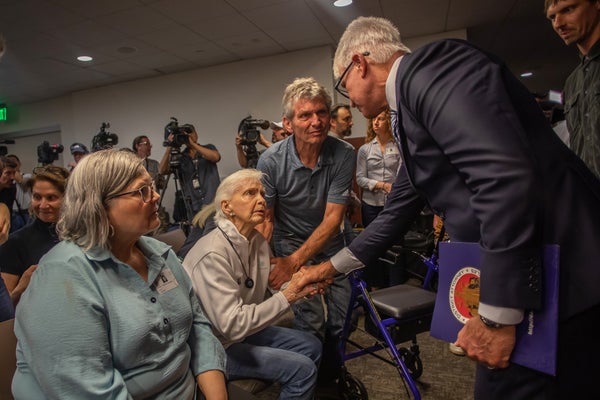November 4, 2024
5 min read
The Law Must Respond when Science Changes
What was once fair under the law may become unfair when science changes. The law must react to uphold due process

Los Angeles County District Attorney George Gascón shakes hands with Joan VanderMolen, sister of Kitty Menendez, after announcing his decision on a possible resentencing recommendation for Erik and Lyle Menendez. The brothers are in prison for the 1989 murders of their parents, José and Kitty Menendez.
It’s been an astounding couple of weeks in the world where science and law intersect. Robert Roberson’s execution is delayed because everybody but the highest courts in Texas and the U.S. now realize that the medical theory on which he was convicted—shaken baby syndrome—originally rested on bad science. The life-without-parole sentences for Lyle and Erik Menendez, convicted of killing their parents, are also in question because researchers at the time did not understand the mental health effects of the abuse they suffered as children.
Whereas the law seeks to provide fair process in a timely fashion, science seeks to discover truth over time. This means that what was once fair may become unfair; the justice of yesteryear may be unjust today. Roberson and the Menendez brothers are the victims of that very divide.
In both cases, scientific understanding changed years ago. Shaken baby syndrome was called into question in the early 2010s, and, years before that, psychologists identified the relationship between the trauma of childhood abuse and violence. Yet all three men have struggled to reopen their cases. An essential principle of science is that it might change as research accumulates. That is a principle that the law has largely failed to come to grips with. This failure threatens the constitutional guarantee of due process.
On supporting science journalism
If you’re enjoying this article, consider supporting our award-winning journalism by subscribing. By purchasing a subscription you are helping to ensure the future of impactful stories about the discoveries and ideas shaping our world today.
The Roberson and Menendez cases are not abnormal. The annals of the law are replete with examples of what we once thought was scientific truth, upon which judges and juries decided both civil and criminal cases, where we later understood the science to be wrong. In 2004 the state of Texas executed Cameron Todd Willingham for the 1992 arson murders of his family. At the time of his execution, the forensic science that linked him to the fire had been categorically invalidated. In a 2015 press release, the FBI reported that in their ongoing review of non-DNA-based microscopic hair identification, 90 percent of cases had errors. Similarly, prosecutors’ use of a questionable theory known as comparative bullet-lead analysis was eventually abandoned after scientific reports debunked its statistical bases. Even today, courts continue to allow bite mark identification testimony, even though people who say they are bite mark experts can’t even agree on whether a bite mark is from a person—or a dog. And what we know about firearms identification and fingerprints are changing— there could be scores of convictions based on what is no longer true.
Society shifts quickly when science changes. Once upon a time, scientists told us that butter was bad for us, and margarine was better; then we learned how much worse margarine could be and started eating more butter again. With lives at stake, justice demands we shift quickly. Indeed, the Constitution’s guarantee of due process is so important that it appears in both the Fifth and 14th Amendments, and promises that “life, liberty, or property” will not be deprived without “due process.”
The law, never a sophisticated consumer of science, needs to become one. When scientific evidence is part of a criminal prosecution, there are two critical things the legal system in the U.S. needs to do to ensure due process.
Judges are supposed to be “gatekeepers” against bad science brought into their courtrooms; this is how the Supreme Court interpreted an evidentiary rule in Daubert v. Merrell Dow Pharmaceuticals in 1993. They must do more to fulfill this obligation. In fact, their failure to fulfill this responsibility means that defendants will be wrongfully convicted, and future courts will be called upon to correct these miscarriages of justice.
For example, the scientific literature supporting pre-1995 arson investigation use or non-DNA hair identification or bite marks, was—and still is—demonstrably inadequate to be admitted in court, much less to alone support a conviction. In 2009 the National Academies of Science published a scathing report on the state of the science of forensic science. In 2016 the President’s Council of Advisers on Science and Technology reviewed the scientific research on several areas of forensic pattern-matching evidence—including DNA, latent fingerprints, bite marks, firearms, hair, and footwear—finding scientific support only for DNA profiling, and giving fingerprints a barely passing score.
Second, the law must provide mechanisms for post-conviction relief based on changed understanding of science, which of course includes when the courts got it wrong the first time around. They can do this, for example, through judicial interpretation of the due process clauses or legislative action. Texas has just such a law on its books, though its enforcement has so far been anemic. Under the Texas statute, a habeas corpus petition may be considered if “relevant [and admissible] scientific evidence is currently available and was not available at the time of the convicted person’s trial because [it] was not ascertainable through the exercise of reasonable diligence … before the date of or during the convicted person’s trial.” In other words, a person who has been convicted, like Roberson, can ask the court to reconsider his case because the scientific evidence has changed.
California has a similar statute, which allows challenges to “false evidence” that was introduced at trial. False evidence is defined as including “opinions of experts that have either been repudiated by the expert who originally provided the opinion at a hearing or trial or that have been undermined by later scientific research or technological advances.” Other states are following suit.
But these efforts are illusory at best, and unconscionable at worst, if courts do not enforce them. Roberson has been on death row for two decades, and the Menendez brothers were sentenced over 28 years ago. The state of Texas has denied Roberson’s attempts at appeals, despite what we now know about shaken baby syndrome. The time that it has taken to reconsider the Menendez brothers’ conviction far surpasses the time required for the science around abuse, trauma and violence to change.
American law has traditionally provided mechanisms to ensure that everyone has their fair day in court. Fairness requires the opportunity to have their cases tried in light of the best science available in the moment. And when the stakes are especially high, as is true in the cases of Roberson and the Menendez brothers, those criminally convicted should have the ongoing right to reopen their cases when our understanding of the science on which their jeopardy resulted has changed. Such an outcome would allow fairness and truth to come together to ensure that justice is done.
This is an opinion and analysis article, and the views expressed by the author or authors are not necessarily those of Scientific American.

